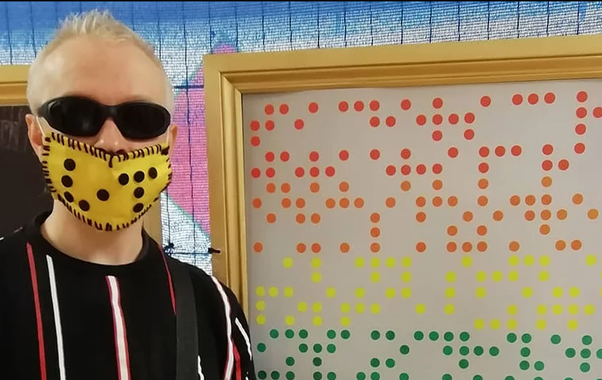Cove Conversations - Clarke Reynolds
May 12 2021 – Paul Mooney

In this series of blogs we ask Cove Gallery artists to choose artists and artworks that have inspired them to give us a closer insight into the influences that drive their creativity.

Clarke Reynolds, who is based in Portsmouth, is an emerging visual artist who is partially blind and gradually losing his sight. His aim is to raise awareness among sighted people of the importance of Braille by using Braille itself as an artistic medium.
Early Influences
Art is my life and as a child there was no other career for me. It started when I saw the painting 'The Yellow Cow' by the artist Franz Marc it opened up my imagination of what art can be.
I was born with limited sight in my right eye but that never stopped me doing what I love, which is being creative. Unfortunately due to kidney problems I had to leave school early, however I fought back and studied art at a higher level gaining a BA honour's degree in model making.
I became a dental model maker I loved my job and also creating art in my spare time. Then I started to lose my sight in my other eye, the worst possible thing that could happen for a visual person. I had to give up my job and was left in limbo.
Tactile Art
I still had my passion for art but found it hard to engage with the materials I previously used as I couldn't see what I was doing. Then I stumbled across textiles and realised that by touching them I felt connected with my artistic process. I took it one step further by sewing with wool, allowing me to add layers to build up a picture like a painter does with paint. And as a painter uses his eyes to what he can see as his inspiration, I on the other hand use sound as my muse, using different fabrics that have a connection with the sound you hear.

I found that I wanted my art to be experienced by everyone, no matter their visual impairment so my art would be fully accessible through sound and touch.
Dots, Pointillism and Braille
My art has changed a lot as my sight decreases, but one thing has always stayed the same – the use of dots in my work as I've always been a fan of pointillism. I always say to people that I see through a thousand dots now, and the dots mean something as I've discovered Braille. Words are vitally important to a visually impaired person as they describe what we see, and as Braille is a tactile language it helps people with low vision to read and communicate.
I use Braille as a form of writing in my artwork, telling stories and trying to push the boundaries of what Braille was intended for. I’d like my art to make sighted people more aware of Braille, using materials and colours that draw people in, using the descriptive power of the dots as a vehicle to bring words and stories to life.
The ultimate aim of my art is to highlight the importance of Braille to visually impaired people, and therefore to society in general.
Colour Recognition
I have created my own colour coded Braille system, in which I identify common sequences of letters that appear in words – for instance ER, ING and ST – and using my knowledge of colour complementarity and shades, I have devised a colour palette to denote each letter of the Braille alphabet.
Just as the brain is able to recognise famous logos through colour and pattern, this theory also applies to my treatment of Braille.
Recent Successes
Over the past two years of exploring Braille as a visual artform, my work has been shown at six online exhibitions, including two international exhibitions. I was commissioned to create an arts trail in Portsmouth, and also a Braille bench in Southampton city centre. I have this year appeared in two art journals and have five planned exhibitions, including my first solo exhibition called “Decoding Braille, Decoding Me” at Yellow Edge Gallery in Gosport between 16th and 27th June. Additionally I was nominated for best visual artist of the year by the Portsmouth Guide Awards in two successive years.

My story as an artist has just begun, and I hope one day people will talk about me in the same vein as Picasso who changed people's perception of art. My dream is to be recognised as an artist that pushes boundaries.
Weymouth Stories - Exhibition and Event – 28 May 2021
When I was asked to exhibit at Cove Gallery, as my art is about words and stories I wanted to create bespoke pieces that link in with the history of Weymouth. I have a strong naval and maritime heritage and have always been drawn to the sea, and during my research I became intrigued by local shipwrecks. One in particular – the Earl of Abergavenny shipwreck in 1805 – stuck out for two reasons. Firstly it left Portsmouth, my home town, before sinking off the coast at Portland, and secondly the Captain of the ship, who perished in the sinking, was John Wordsworth, the brother of the great English poet William Wordsworth.

Wordsworth was profoundly affected by the loss and wrote a poem William Wordsworth wrote a poem dedicated to his brother and all those who perished, which is now reproduced on a plaque on the Stone Pier in Weymouth. In one of the pieces for the exhibition I have recreated this information in my Braille colour code.

Another piece for the exhibition shows the Dorset flag, which I’ve reproduced in colour coded Braille, and retells the history of Weymouth from 1318-2021.



0 comments